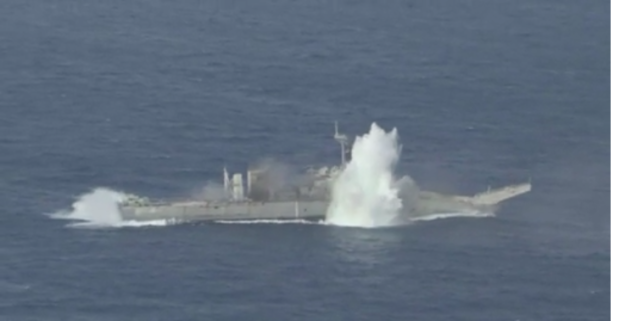WATCH: US, Australia and Japan sink old warship as China keeps tab
The United States, Australia and Japan displayed a new level of cooperation as it joined forces in sinking an old warship as part of Rimpac (Rim of the Pacific), the world’s largest maritime exercises, while China was keeping tabs nearby.
A video of the sinking exercise by the three countries was posted on social media on Monday (Philippine time).
It's a HIT! 🎯
Live fire from aircraft, a submarine, and land assets have sunk the decommissioned the Tank Landing Ship, ex-USS Racine, during the Sinking Exercise, or SINKEX.#RIMPAC #RIMPAC2018 #CapableAdaptivePartners pic.twitter.com/6cMhxG0GXN
— RIMPAC (@RimofthePacific) July 16, 2018
The three countries deployed an aircraft, a submarine, and land assets to sink the decommissioned USS Racine (LST-1191) in waters 15,000 feet deep at 55 nautical miles north of Kauai in Hawaii last July 12, the US Navy said.
Article continues after this advertisementRELATED: China faces consequences for intimidation, US warns
Article continues after this advertisementIt featured the live firing of surface-to-ship missiles by the Japan Ground Self-Defense Force and a naval strike missile from a launcher on the back of a palletized load system by the US Army.
The Royal Australian Air Force sent a P-8A Poseidon aircraft for the exercise for maritime reconnaissance.
The Los Angeles class submarine USS Olympia (SSN-717) later fired a Harpoon missile, followed by a MK-48 torpedo.
“Today, we demonstrated the lethality and adaptability of our joint forces in the maritime environment,” said Adm. Phil Davidson, commander of the US Indo-Pacific Command.
“As naval forces drive our enemies into the littorals, army forces can strike them. Conversely, when the army drives our enemies out to sea naval firepower can do the same,” he added.
The US withdrew its invitation to China for the Rimpac weeks before it started last June, as the Asian giant’s behavior was seen as “inconsistent with the principles and purposes of the exercise.”
At the Shangri-la Dialogue in Singapore last month, US Defense Secretary James Mattis said the decision was a “small consequence” to China’s militarization of the South China Sea.
Media reports said that China sent one of its surveillance ships in the vicinity of Hawaii outside US territorial seas last week, coinciding with the exercises.
PH joins at-sea phase
This year’s Rimpac also marks the first time that the Philippines joined the exercises. This week, the Philippine Navy’s BRP Andres Bonifacio (FF-17) and BRP Davao del Sur (LD-602) sailed for the sea phase.
Navy public affairs office chief Commander Jonathan Zata said the Philippine Navy has started with its serialized training which includes visit, board, search, and seizure; gunnery exercise; replenishment at sea; and combined anti-submarine and anti-air exercises.
READ: New milestone for PH Navy as it joins largest maritime exercises
Participating members of the Philippine Marines also started with air assault operations and fire and maneuver exercises.
“The Navy’s participation to the world’s largest international maritime exercise validates the various tactical procedures for combined maritime and Marines operations of the two cutting edges of the Philippine Navy — the Philippine Fleet and the Philippine Marine Corps,” Zata said.
This year’s Rimpac runs from June 27 to August 2, with the participation of 25 countries. There are 46 surface vessels, 200 aircraft, and about 25,000 personnel joining the international exercises. /muf
